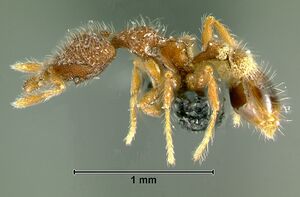Strumigenys inhonesta
| Strumigenys inhonesta | |
|---|---|

| |
| Scientific classification | |
| Kingdom: | Animalia |
| Phylum: | Arthropoda |
| Class: | Insecta |
| Order: | Hymenoptera |
| Family: | Formicidae |
| Subfamily: | Myrmicinae |
| Tribe: | Attini |
| Genus: | Strumigenys |
| Species: | S. inhonesta |
| Binomial name | |
| Strumigenys inhonesta Bolton, 2000 | |
Known from a small number of collections from wet forest. One was a nest collection from a clay bank and another was made from the litter.
Identification
Bolton (2000) – A member of the Strumigenys akalles-group. See notes under Strumigenys akalles.
Keys including this Species
Distribution
Tang & Guenard (2023) - The record of S. inhonesta in Thailand extends its native range 1500 km eastward and represents the first record of this species within continental Asia. Its presence in other parts of the Indochinese Peninsula, such as Peninsular Malaysia is likely.
Latitudinal Distribution Pattern
Latitudinal Range: 7.5° to 4.95°.
| North Temperate |
North Subtropical |
Tropical | South Subtropical |
South Temperate |
- Source: AntMaps
Distribution based on Regional Taxon Lists
Indo-Australian Region: Borneo, Indonesia (type locality), Malaysia, Philippines, Sulawesi.
Oriental Region: Thailand.
Distribution based on AntMaps
Distribution based on AntWeb specimens
Check data from AntWeb
Countries Occupied
| Number of countries occupied by this species based on AntWiki Regional Taxon Lists. In general, fewer countries occupied indicates a narrower range, while more countries indicates a more widespread species. |

|
Estimated Abundance
| Relative abundance based on number of AntMaps records per species (this species within the purple bar). Fewer records (to the left) indicates a less abundant/encountered species while more records (to the right) indicates more abundant/encountered species. |

|
Biology
|
Castes
Worker
  
| |
| . | Owned by Museum of Comparative Zoology. |
Nomenclature
The following information is derived from Barry Bolton's Online Catalogue of the Ants of the World.
- inhonesta. Strumigenys inhonesta Bolton, 2000: 749 (w.) INDONESIA (Sulawesi).
Unless otherwise noted the text for the remainder of this section is reported from the publication that includes the original description.
Description
Worker
Holotype. TL 2.2, HL 0.58, HW 0.47, CI 81, ML 0.16, MI 28, SL 0.30, SI 64, PW 0.26, AL 0.60. In full-face view with mandibles fully closed the length of the left preapical tooth is distinctly less than the distance between the base of the tooth and the base of the mandible. Leading edge of scape with fine projecting hairs, the longest of them slightly greater than the maximum width of the scape. Dorsolateral margin of head with abundant freely laterally projecting hairs that are fine, soft and relatively short, shallowly curved and shorter than the length of the scape. Erect hairs on cephalic dorsum and promesonotum fine and soft, relatively short but flexuous to sub flagellate. Clypeus with fine granular to punctulate sculpture, not as strongly sculptured as cephalic dorsum. Promesonotal dorsum finely densely punctulate everywhere.
Paratype. TL 2.1, HL 0.56, HW 0.44, CI 79, ML 0.14, MI 25, SL 0.28, SI 64, PW 0.24, AL 0.58.
Dimensions of non-paratypic workers. HL 0.58-0.60, HW 0.47-0.49, CI 80-82, ML 0.15-0.16, MI 25-27, SL 0.30-0.32, SI 63-67 (3 measured).
Type Material
Holotype worker, Indonesia: Sulawesi Tengah, n r Morowali, Ranu Riv. Area, 27.i.-20.iv.1980, BM 1980-280 (M. J. D. Brendell) (The Natural History Museum).
Paratype. 1 worker with same data as holotype (Museum of Comparative Zoology).
References
- Bolton, B. 2000. The ant tribe Dacetini. Memoirs of the American Entomological Institute. 65:1-1028. (page 749, worker described)
- Tang, K. L., Guénard, B. 2023. Further additions to the knowledge of Strumigenys (Formicidae: Myrmicinae) within South East Asia, with the descriptions of 20 new species. European Journal of Taxonomy 907, 1–144 (doi:10.5852/ejt.2023.907.2327).
References based on Global Ant Biodiversity Informatics
- Bolton, B. 2000. The Ant Tribe Dacetini. Memoirs of the American Entomological Institute 65
- Pfeiffer M., and D. Mezger. 2012. Biodiversity Assessment in Incomplete Inventories: Leaf Litter Ant Communities in Several Types of Bornean Rain Forest. PLoS ONE 7(7): e40729. doi:10.1371/journal.pone.0040789
- Pfeiffer M., and D. Mezger. 2012. Biodiversity Assessment in Incomplete Inventories: Leaf Litter Ant Communities in Several Types of Bornean Rain Forest. PLoS ONE 7(7): e40729. doi:10.1371/journal.pone.0040898
- Pfeiffer M.; Mezger, D.; Hosoishi, S.; Bakhtiar, E. Y.; Kohout, R. J. 2011. The Formicidae of Borneo (Insecta: Hymenoptera): a preliminary species list. Asian Myrmecology 4:9-58
- Woodcock P., D. P. Edwards, T. M. Fayle, R. J. Newton, C. Vun Khen, S. H. Bottrell, and K. C. Hamer. 2011. The conservation value of South East Asia's highly degraded forests: evidence from leaf-litter ants. Phil. Trans. R. Soc. B. 366: 3256-3264.
- Woodcock P., D.P. Edwards, T.M. Fayle, R.J. Newton, C. Vun Khen, S.H. Bottrell, and K.C. Hamer. 2011. The conservation value of South East Asia's highly degraded forests: evidence from leaf-litter ants. Phil. Trans. R. Soc. B 366: 3256-3264.

